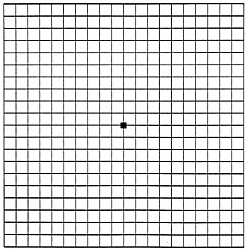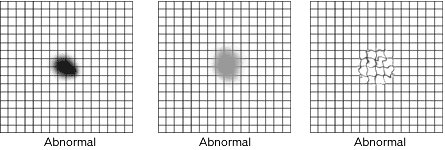Your Changing Eyes |
Macular degeneration is a condition of the eye that is often related to aging. It is commonly referred to as age-related macular degeneration, and is abbreviated as AMD.
While its cause is unknown, the early or late stage of AMD affects over 800,000 Canadians over the age of 40. The late stage associated with vision loss, is the most common cause of legal blindness in people over the age of 50 in the western world.
In AMD, the macula of the eye is affected. The macula is a light-sensitive tissue lining the back of the eye in the central area of the retina. The retina receives images of external objects, then sends them as impulses to the brain.
The macula provides us with central vision and allows us to see fine detail, such as recognizing a face, reading, or watching television. When the macula becomes damaged, extreme and dramatic vision loss can occur.
 |
 |
|
Normal
|
Macular Degeneration
|
The early stages of AMD typically start with the appearance of spots beneath the retina. These spots, called drusen, are small, round lesions which usually do not change vision very much.
However, certain changes may occur that lead to the late stage of AMD, which is usually accompanied by vision loss. Most often, vision loss starts in one eye. Because the healthy eye compensates for the loss of vision in the damaged eye, macular degeneration may initially go unnoticed. In some cases, it will also affect vision in the other eye.
Types of Macular Degeneration
There are two main types of macular degeneration, the "dry" form and the "wet" form. With the dry form, the macula thins and does not function properly. This type is the most common, affecting 85-90% of patients, and is slow-progressing. Unfortunately, surgical treatment has not been shown to be effective for the dry type.
The wet form affects only about 10% of patients, and involves the growth of abnormal blood vessels under the retina. The wet form of AMD is responsible for up to 90% of the severe vision loss associated with AMD. Back to top
How Wet AMD is Treated
There are two treatments available for patients with wet AMD. One of these is laser photocoagulation. While this process usually cannot restore lost vision, it seals leaky blood vessels and inhibits their growth in selected cases. This prevents further vision deterioration in a small percentage of wet AMD cases.
In laser photocoagulation, a laser is used to provide a concentrated beam of high-energy light. When the light comes in contact with the parts of the retina to be treated, it turns to heat and destroys the abnormal blood vessels.
As a result, a scar forms in the area treated, creating a permanent blind spot in the field of vision. That is because laser photocoagulation also destroys overlying retinal tissue. However, the loss of vision is usually less severe than the eventual loss of vision that would likely occur if no laser treatment was performed.
Another Option
Another treatment for wet AMD is photodynamic therapy. In this procedure, a light-activated drug known as Visudyne® is injected into the patient’s bloodstream. Once the drug reaches the retina, it is activated by a non-thermal laser (a laser that does not burn the retina). This produces a clot that closes the abnormal vessels without causing damage to the overlying sensory retina. The abnormal blood vessels may return after several months. However, photodynamic therapy can be reapplied at up to 3 month intervals if necessary.
How Can You Prevent or Retard the Progression of Macular Degeneration?
Because the effects of macular degeneration are usually not noticed until damage has already been done, it is often difficult to prevent the condition. However, practicing preventative measures is recommended in efforts to retard the progression of the condition. These include: staying away from overexposure to UV sun rays by staying out of the sun or wearing protective sunglasses, not smoking, eating well, and making sure you get the vitamins and minerals that you need.
Nutritional Supplements
A healthy diet high in antioxidant vitamins and minerals has long been associated with the prevention or delay of AMD. New research indicates that two antioxidant carotenoids, LUTEIN and ZEAXANTHIN, may help in the prevention of AMD by protecting the macula against blue light damage. Good sources of lutein and zeaxanthin are green leafy vegetables, especially spinach. For people who don’t get adequate nutrition through their diet, a nutritional supplement such as Vitalux, may help.
Detection
The Amsler Grid
The best way to retard the progression of macular degeneration is to detect changes or problems in vision as early as possible. In order to do this, you must be aware of what you are seeing with each eye. The best eye test for detecting small changes in vision is the Amsler Grid:

How to Use the Amsler Grid (repeat for each eye):
Note: If you wear reading glasses, be sure to have them on when using the Amsler Grid.
- Look at the grid with one eye at a time, covering the other eye with your hand.
- Make sure you stay focused on the center dot.
- Continue to stare at the center dot, looking to see that all the lines are straight and all the squares are the same size.
- If any area on the grid appears blurred, distorted, discoloured, or in any way abnormal, contact your eye care professional immediately.

